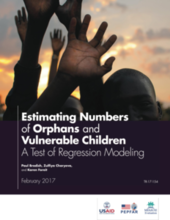EXECUTIVE SUMMARY
Knowing how many orphans and vulnerable children (OVC) may require services can enhance the efficiency of programming. The OVC technical working group of the U.S. President’s Emergency Plan for AIDS Relief (PEPFAR) requested help from MEASURE Evaluation (funded by the U.S. Agency for International Development [USAID]) to develop procedures—preferably using published final reports of standardized surveys such as the Demographic and Health Surveys (DHS)—to estimate the sizes of OVC groups having high programmatic priority at the national and subnational levels.
An earlier study reported a tight linear fit between national adult HIV prevalence and the percentage of children living in a household with at least one HIV-positive adult. MEASURE Evaluation extended this analysis to all existing DHS data sets with HIV testing, to determine the feasibility of using regression modeling to estimate the size of two priority groups: (1) children living with at least one adult who is HIVpositive, and (2) orphans and coresident children living with at least one adult who is HIV-positive.
At the national level, we found reasonably tight linear relationships between HIV prevalence among adults and the proportion of children living with at least one HIV-positive adult and between adult HIV prevalence and the proportion of orphans and coresident children living with at least one HIV-positive adult. However, at the subnational level, owing to small sample sizes, we found greater variation at the same level of HIV prevalence in the proportion of children living with an HIV-positive adult. Although the slopes and intercepts of the national and subnational regression lines are almost the same, the confidence intervals for the subnational level estimates are very wide and many data points fall outside the prediction.
PEPFAR has given priority for OVC programs to 21 countries. Of these, 17 have a recent biomarker survey: Burundi, Cameroon, Cote d'Ivoire, Democratic Republic of Congo, Ethiopia, Haiti, Kenya, Lesotho, Malawi, Mozambique, Namibia, Rwanda, Swaziland, Tanzania, Uganda, Zambia, and Zimbabwe. For these countries, we recommend using the results of our secondary DHS analyses for programmatic estimates. Our Excel workbook (OVC estimates from DHS, available here: https://www.measureevaluation.org/resources/files/ovcestimates-from-dhs…) includes point estimates and 95-percent confidence intervals at both the national and subnational levels of the proportions of children who live in a household with an HIVpositive adult and the proportion of children who are orphans or coresident children living in a household with an HIV-positive adult, and extrapolates the observed proportions to numbers of children.
At present, four countries in the PEPFAR OVC portfolio do not have a recent DHS survey with HIV testing: Botswana, Nigeria, South Africa, and South Sudan. For these countries, the linear regression is a reasonable way to estimate at the national level the proportion of children who live in a household with an HIVpositive adult and the proportion of children who are orphans or coresident children living in a household with an HIV-positive adult. We have created an Excel workbook to predict these two indicators at the national level and to extrapolate the predicted proportions to numbers of children (OVC estimation calculator, available here: https://www.measureevaluation.org/resources/files/ovc-estimationcalcula…).
Although the calculator works for size estimation at the national level, we strongly recommend that it not be used at the subnational level, owing to low accuracy of the estimates.

